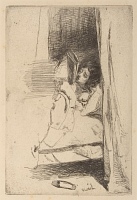Etchings Institutions search term: grolier club
The Slipper | ||
| Number: | 43 | |
| Date: | 1859 | |
| Medium: | etching and drypoint | |
| Size: | 120 x 80 mm | |
| Signed: | 'Whistler -' at lower right | |
| Inscribed: | no | |
| Set/Publication: | no | |
| No. of States: | 2 | |
| Known impressions: | 26 | |
| Catalogues: | K.28; M.28; T.29; W.29 | |
| Impressions taken from this plate (26) | ||
KEYWORD
TITLE
'La dame lisant' (1859, Francis Seymour Haden, Sr (1818-1910)). 4
'Reading in Bed' (1872, British Museum). 5
'The Slipper' (1873/1874, Whistler). 6
'Reading in Bed' (1874, Ralph Thomas, Jr (1840-1876)). 7
'The Slipper' (1881, Union League Club). 8
'Reading in Bed' (1886, Frederick Wedmore (1844-1921)). 9
'The Slipper' (1909, Howard Mansfield (1849-1938)). 10
'La dame lisant' (Woman Reading) is the earliest title, recorded by Haden, the sitter's husband, followed by 'Reading in Bed', which was the title known to Percy Thomas (1846-1922) (who sold an impression to the British Museum in 1872) and Ralph Thomas. The Thomas brothers may well have been present when the etching was being reworked and printed in London in 1861.
However, the slightly unusual title 'The Slipper' was that given by Whistler in the early 1870s, by Samuel Putnam Avery (1822-1904) (in the 1881 catalogue) and by Mansfield. The lonely slipper in the foreground of the interior provides good justification for this title, which diferentiates it clearly from similar subjects, particularly another portrait of the same sitter, Reading by Lamplight [37].
4: Haden to A. Delâtre, 29 June [1859], GUW #13140.
5: B.M. Print Room Register of Purchases...1872.
7: Thomas 1874 (cat. no. 29).
8: New York 1881 (cat. nos. 43-44).
9: Wedmore 1886 A (cat. no. 29).
10: Mansfield 1909 (cat. no. 28).
DESCRIPTION
11: Mansfield 1909 (cat. no. 28).
SITTER
Wedmore suggested that in the second state, 'This change was made in 1861, its object, as I suppose, being to destroy a likeness otherwise apparent'. 13 Cosmo Monkhouse objected:
12: Lochnan 1984 , pp. 59-60.
13: Wedmore 1886 A (cat. no. 29).
14: 'Whistler's Etchings: a Study and a catalogue by Frederick Wedmore (Thibaudeau)', The Academy, 10 February 1887, p. 136.
SITE
If the sitter is definitely Deborah Haden, then the site is almost certainly the Hadens' house in Sloane Street, London.
15: Thomas 1874 (cat. no. 29); Lochnan 1984 , pp. 59-60.
DISCUSSION
16: Wedmore 1886 A (cat. no. 29).
17: Lochnan 1984 , pp. 59-60.

